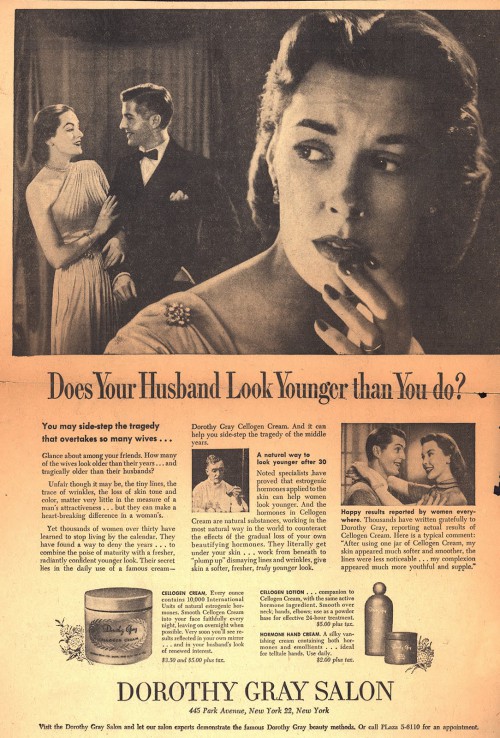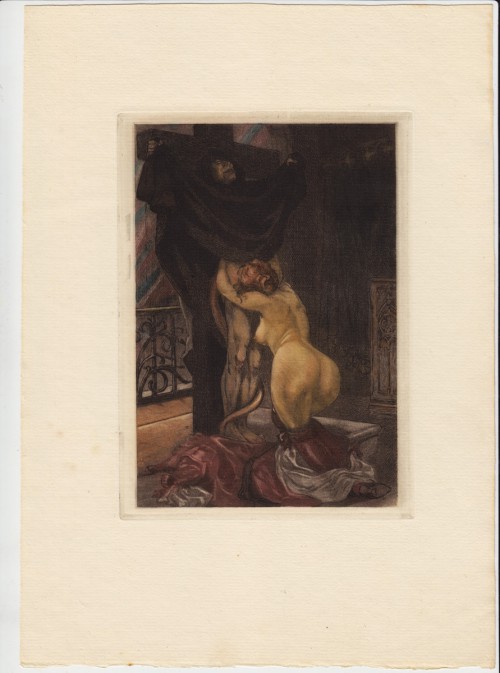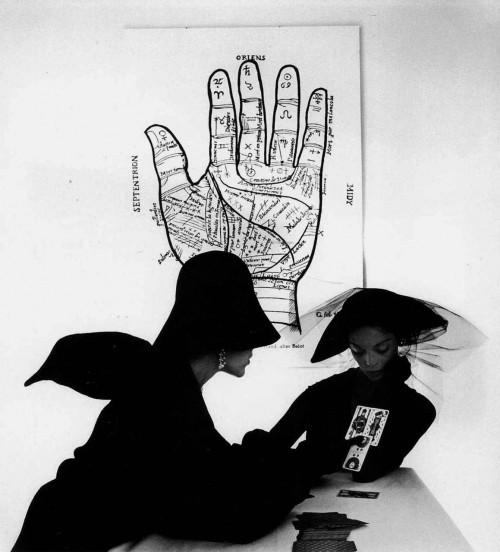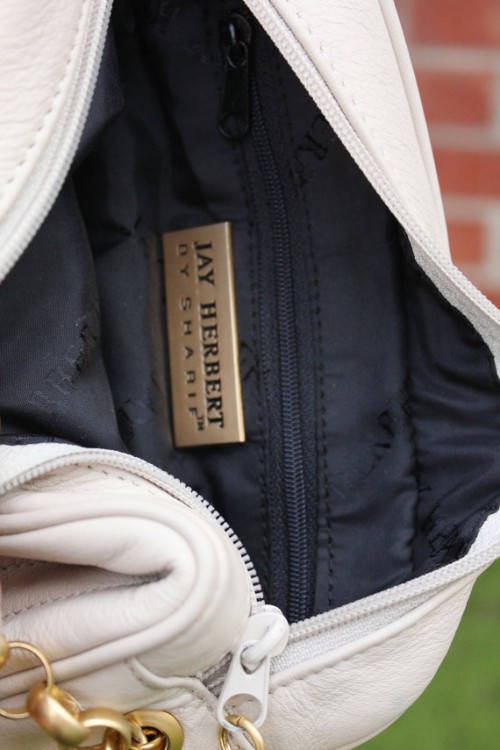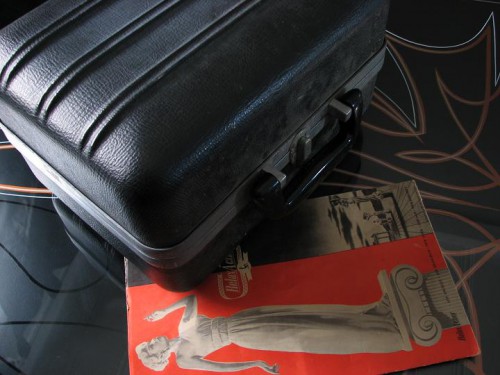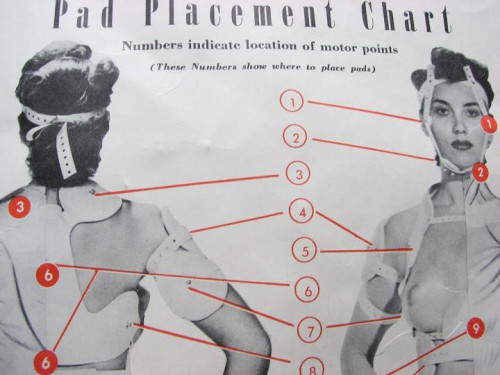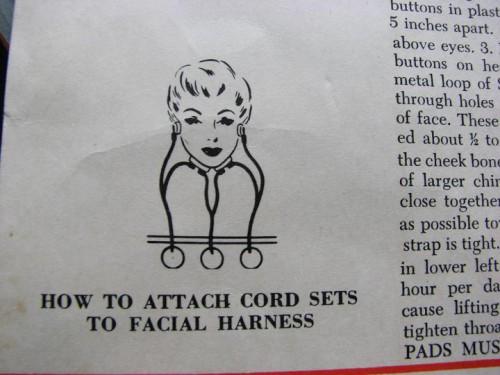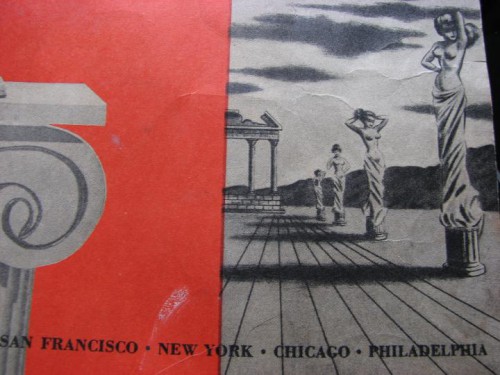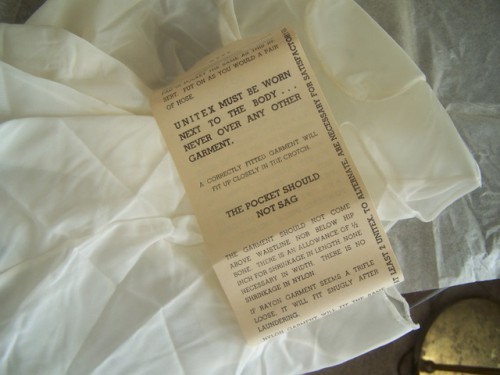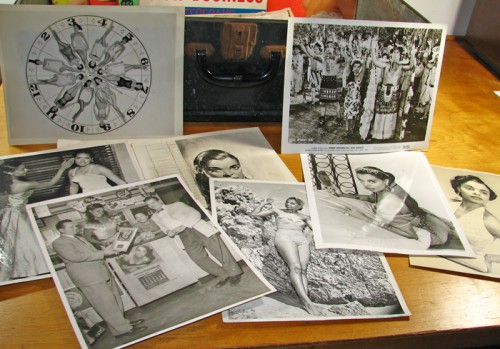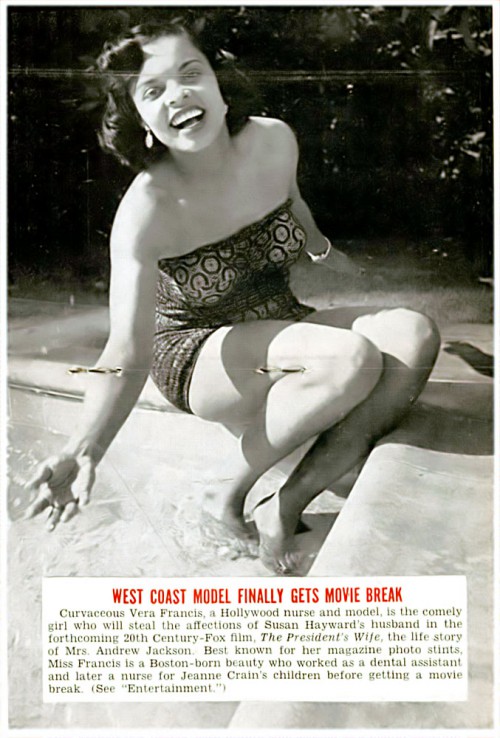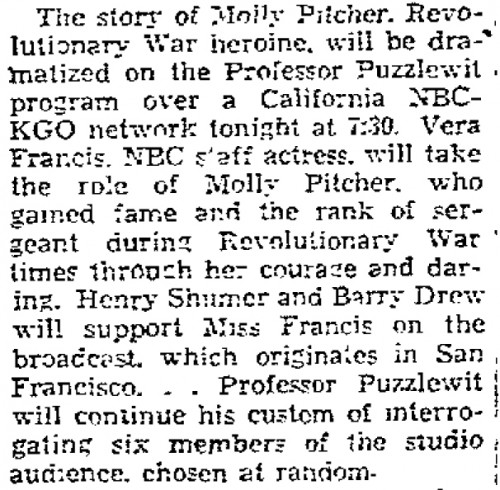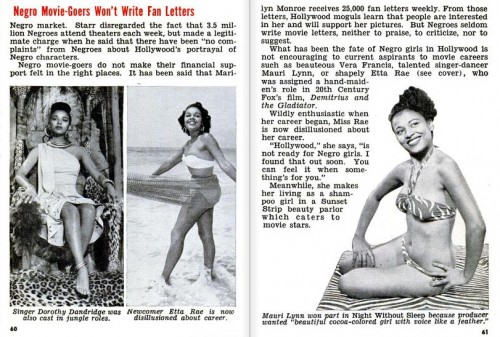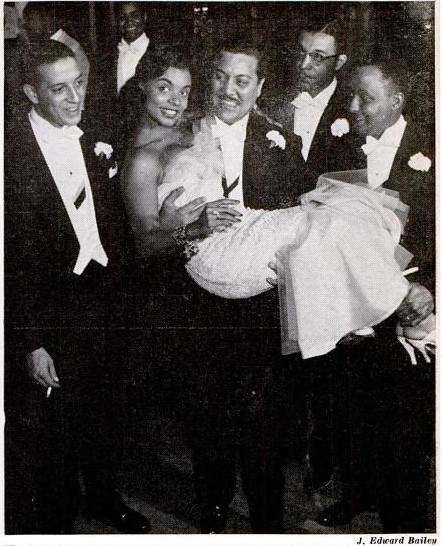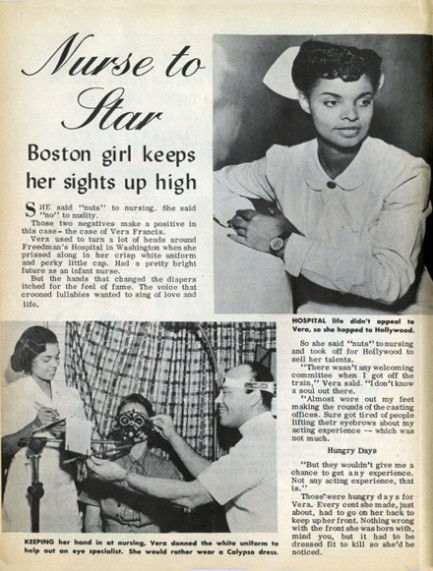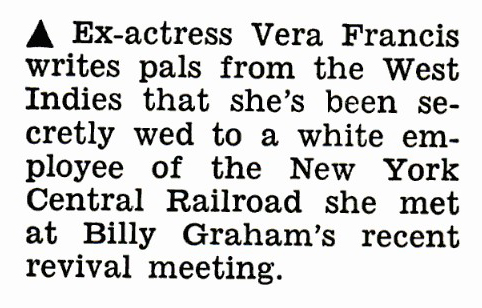Kathleen Martyn, Ziegfeld Girl, with a butterfly on her back shoulder.
Tag: vintage
What’s Up With ASCII Art Nudes?
Today, at Collectors Quest, I get to find out the truth behind what shocked my teenaged-self so much: keyboard art nudes.
Seems that what I’d seen then was ASCII art, but more likely done by a computer program operating off of a photograph, not a person. I guess it makes more sense that way… Some computer nerds (or geeks?) at the office goofing off with technology, not doing art for art’s sake by hand. (Though, I suppose, to be fair and sex positive, hands were likely involved at some point.)
The image is from this gallery of ASCII art nudes. This is “Ms Collins” or “Vicki” from created from Oui magazine, February 1973. I selected her because she seems a lot like one of the nudes I’d seen that fateful day.
…A day way back then, when parents could display nude artwork and not cringe or worry when they gave the babysitter a tour of their house.
The History Of Driving While Black
I’ve written before about why I don’t collect Black Americana; as a white chick, I don’t feel I have the right to document such history. (I’ll stick with documenting women’s lives with my collecting, thank you.) But since collecting the history of oppressed people intrigues me, I really enjoyed this article about David Pilgrim’s collection which will soon be on display at the grand opening of the Jim Crow Museum of Racist Memorabilia on April 26th at Michigan’s Ferris University.
I love a good story about collecting, and Pilgrim’s begins thus:
David Pilgrim was 12 years old when he bought his first racist object at a flea market: a saltshaker in the shape of a Mammy. As a young black boy growing up in Mobile, Alabama, he’d seen similar knick-knacks in the homes of friends and neighbors, and he instinctively hated them. As soon as he handed over his money, he threw his purchase to the ground and shattered it into pieces.
But it get’s really interesting when Jennie Rothenberg Gritz, an Atlantic senior editor who wrote the piece and interviewed the collector, asked Pilgrim about his progression from destroying the objects to collecting them:
I went to a historically black college, Jarvis Christian College in Texas, and in addition to teaching the usual math and science, our professors would tell us stories of Jim Crow. One day, one of my professors came into the classroom with a chauffer’s cap. He set the hat down and asked what historical significance it had.
Now, the obvious answer was that blacks were denied many opportunities, and chauffeuring was one of the few jobs open to them. But that was not right answer. He told us that a lot of professional middle-class blacks in those days always traveled with a chauffer’s hat. The reason: If they were driving a nice new car through a small southern town, they didn’t want police officers, or any other whites, to know the car belonged to them.
I remember that story so vividly. No object has any meaning other than what we assign to it. But that was an incredible meaning to assign to an object that, on the surface, had little to do with racism.
This is not only proof of my theory about using collectibles to teach, but it shows just how old the problem of Driving While Black really is.
Beauty After The Atomic Bomb?
Advertising based on fears — especially the female fears of beauty, “catching” and “keeping” a man — are nothing new. This vintage print ad for Dorothy Gray captures those horrors.
However, this vintage TV commercial for a pre-cold war cold cream preys on more than beauty fears. Circa the 1950s, this commercial for Dorothy Gray Cosmetics boasts how the cleanser removes two and a 1/2 times the radiation of other cleansers. No word on how much radiation is left behind or even it it’s enough to kill you…
Harlots On Bikes With Numb Genitals
There’s been so much written on the history of women being liberated by bicycles (there’s even a new book on the subject: Wheels of Change: How Women Rode the Bicycle to Freedom (With a Few Flat Tires Along the Way)) that it difficult to believe that riding bikes decreases women’s sexual sensation.
As a feminist, I’ve often understood the old health concerns simply to be over-reactions — or outright orchestrations to limit women. But I bet some of those doctors are rolling over in their graves now.
However, this study would seem to refute the accusations that females on bikes were harlots.
If It’s Antique Is It Still Porn? (NWS)
If you thought the matter of who makes art exploring the issue of abortion difficult, perhaps the following antique erotic artworks will be too upsetting. That’s your warning to leave.
For these works go beyond the issue of basic nudity in art, beyond even the matter of erotic art, to explore sexuality along with religion and what appears to be the opulence of wealth.
I’m no expert, in art or in the French language, but I’m rather certain these works by Marcel Vertes (Le Pays a Mon Gout aka The Country to Your Taste, 12 original lithograph prints, circa 1921) and Martin van Maele (De Sceleribus et Criminibus , 11 erotic etchings circa 1908) are not theoretical works expressing confusion or commentary on the corruption of religion or other issues of decadence, but rather are fantasies exploiting such distorted delights — i.e. they are 100% erotica, illustrated meant to arouse.
But does that make them any less interesting in terms of art? Does their age make them more credible as art? Does the status of the artists, one an Oscar winner the other an illustrator for the works of H. G. Wells, improve your opinion? Is it art, erotica, or just plain old porn?
…And if you say “porn” or “old porn,” doesn’t that mean it still moves you?
Which would rather give points for “timeless” or “classic” to the works as well as kudos to the artists themselves, wouldn’t it?
Fashion Forecasting With Tarot Cards, Part Two
The Tarot Reader, photographed by Irving Penn and published in the October 1949 issue of Vogue, predates our earlier fashion forecasting post. The models are Bridget Tichenor and Jean Patchett.
Combining My Love Of Vintage Fashions With My Feminist Notions To Create An Intoxicating Confusion
At Here’s Looking Like You, Kid, Jaynie shares a feature on Christian Dior’s New Look fashions published in the February 2012 issue of Harper’s Bazaar. Here’s the most lovely conflicting passage I wish to direct your attention to:
“Dior said that the forward thrust of the hips was a way for women to advertise their childrearing abilities, so he was certainly tapping into the emergence of the baby boom,” says Timothy Long, the costume curator at the Chicago History Museum. “But there’s no surprise that that whole idea of hyperfemininity is going to continue.” Long is the force behind the current exhibition Charles James: Genius Deconstructed which sheds new light on the unique way that the American couturier-said to have influenced Dior- crafted his dresses.
Does this mean that those 1950s-1960s New Look fashions we find so sexy are indeed incredibly sexist — by design? Or is our fertile femininity to be acknowledged, even celebrated, without judgement? It’s nearly impossible to say… History teaches us just how limited and controlled women were in those times. And the return of such looks — can it be completely coincidental in terms of the current assault on women?
The Charles James exhibit is at the Chicago History Museum through April 16, 2012. Maybe if I can get there, I can figure some of this out.
The Power Of Shared Experience In Music

I’m no music aficionado. I like what I like. But I have to hear it first. Which means I’m not such a fan of music reviews.
Music reviews always seem so foreign to me… Using words to describe music? What’s next, writing a musical arrangement as a review of a book? Yeah, yeah, yeah, we use words to communicate; so even if music is communication in-and-of-itself, we use words to define it, explain it, sell it, share it. I myself trust what I hear.
So why, then, am I reading Simon Sweetman’s Blog On The Tracks — let alone adding “him” to the sidebar?
It’s not just our mutual love of Trini Lopez, or even vinyl. It’s because Sweetman makes me think thinky things.
In considering the value of music, records, and music collections — tangible objects which help keep music from being too temporal — there’s an elusive emotional component which is hard to put a price on… Yet it’s largely what makes music so important. It’s the power of the shared music experience.
The original joy of music was once a primarily shared experience. Folks gathered around fires, singing together — maybe a few slapping a thigh or smacking a rock or whatnot. But there was no level of “good enough to participate” in terms of pitch or talent or anything. And you can easily argue that even the lone hunter whistling or humming was recalling that tune from some earlier social feast when the group shared a melody. There was no professional musician then. Those guys and gals would come later.
And when they did, music was still about a shared experience. Not just in the Sing Along With Mitch way either. If you don’t believe me, get thee to a concert sometime. Or even your local watering hole — it needn’t have a live band, just a jukebox will do — and you’ll hear people singing (somewhat) along with the song, or slapping their thigh or whatnot. For that matter, how many times a week does your neighbor share their music selections with you via the unnecessarily loud volume? How about those cars which you hear approaching by the distorted vibrational boom of blasting base? In fact, folks today with their isolated musical experiences of earbuds will not be silent in their solos; they must share. Even if you cannot hear the song selection itself play, you are forced to hear your coworker scream-sing along. Or at least you think that’s what they are doing… You can’t actually identify the song, even if you can decipher the lyrics, but you’re pretty sure that’s “singing.”
The very fact that music with lyrics is the most popular type of music reinforces this notion of the power of shared musical experience; we want to participate by singing along.
The shared music experience is powerful. Congregations are built upon it. Relationships strengthened, and breakups survived, via those mixed tapes (which have not disappeared but merely moved to MP3 playlists). Even if the kids resist it at first, they come around to the power of shared musical experiences — even with their parents. That’s pretty compelling evidence.
Vintage Jay Herbert
On a recent visit to Fargo’s Antiques On Broadway, I spotted this vintage lighter (still in the box) advertising Jay Herbert of California and the stylized name looked familiar…
A quick image search on Google, and I received the instant gratification I sought: vintage fashion labels for Jay Herbert of California.
My favorite is this fancier version in which the scroll work at the bottom somehow remind me of scissors. It still holds it’s logo value today, for somehow, in all my perusals of vintage fashions over the years, I retained the sight of it enough to recognize it on the lighter.
If I had to guess, I’d say the fancier labels are the older ones. But it would only be a guess. For aside from department store ads in old newspapers announcing the Jay Herbert of California brand, there’s scant information available on the fashion house.
One thing is for certain, though: Jay Herbert was not a fashion designer or even an actual person. Buried in a precedent setting legal case regarding the definition of an employee (at least for tax purposes), I discovered that Jay Herbert of California was the business name of partners Herbert Owen and Joseph Silverstein who “engaged in the manufacture and sale of ladies’ dresses” in 1960.
That technically means that references to Jay Herbert as a designer are false.
But there’s even more ambiguity…
It appears that Jay Herbert of California began appearing in vintage department store advertisements in the late 1950s but by the mid 1960s they fade away… And decades later, in the 1980s, the name Jay Herbert appears again — on handbags and wine caddies — but now simply as Jay Herbert, New York.
I’m rather smitten with this vintage or retro Jay Herbert New York handbag.
I’m not sure if this Jay Herbert, most known for their coveted quilted Chanel-inspired handbags, is related past anything but name. Trademark searches show no records for the name Jay Herbert, Jay Herbert of California, or Jay Herbert New York. The name could have been sold, licensed, or, having no protections, even just capitalized upon as having some recognition with retailers.
More contemporary handbags appear with metal tags bearing the Jay Herbert name and metal “coin” logos — but these handbags and purses are “by Sharif.”
Sharif, like Cher, uses only one name. The designer bags are sold mainly (if not only) on HSN. The designer incorporated as Sharif Designs Inc. in 1979, but it has a family history dates back to 1827 in Egypt.
Personally, I prefer the vintage bags over the new ones, and the vintage fashions even more. But it’s the vintage labels and logos I love most of all.
I hope this helps you with your Jay Herbert shopping and collecting. If you can add any information, please do!
Image Credits: Simple Jay Herbert of California label via Half A Second Art and Vintage; fancy Jay Herbert label via Timeless Vixen Vintage; Jay Herbert New York purse label via Barefoot & Vintage; Jay Herbert New York wine caddy label via DJVintage; retro quilted Jay Herbert purse via A Little Luxury; two photos of Jay Herbert by Sharif metal tags via Mr. Mister Vintage
Sockingly Awesome, Wretched Vintage Beauty Quackery Device: The Relax-A-Cizor
Any of these old beauty gadgets or quack medical items draws my interest — but when an electrical item demands you make the pads which attach to wires wet, well, I’m in love!
I’d love to own this not-so-little gem, but it’s beyond my budget. *pout* Here’s an awesome description from the seller:
The Relax-A-Cizor is an Electrical Muscle Stimulator. They date from the late 1940’s to the early 1970’s, and sold for $200- $400.
It claims to reduce girth by giving electric shocks to the muscles. Wet pads are strapped or placed on the body, attached by cords to a power source.
Pads can be placed on the stomach, thighs, arms, etc., even the face. Then you just lie there and electric shock yourself into a fabulous figure, yay!
Sounds scary, huh?In 1971 the FDA declared the Relax-A Cizor to be dangerous, causing or aggravating medical conditions.
This is after selling thousands of units for decades!
The FDA ordered the destruction of units, or for them to be made inoperable. They also banned the resale of already purchased units. So, given all that information, this auction is for the purpose of Collecting Medical Quackery Items only. This Relax-A-Cizor is not being sold as an excercise or fitness machine.
This auction contains:
the original hard case
electrical console with dials, toggle, and inputs
The original instructions
6 disks with pads
face pads and strap
chest pads and vest
extra straps
chin pad
cordsThe instructions have gorgeous drawings of statue like women, some naked, I love the art, fabulous! There are photographs of pad placement in these instructions, including some nudity.
The funniest thing about the instructions (in my opinion), is the lack of warnings. In fact, the only warning is to NOT store wet pads in the box. The only other warnings are to make sure to lie down, and to get the pads thoroughly wet, nothing about being shocked!
This is a true medical oddity.
This Relax-A-Cizor is in excellent condition. The pads and straps have some discoloration from use, age, and storage. I’m not sure if this unit is complete, there is no item list. The paper instructions are in excellent condition, there is a hand written note taped to the inside. The case is in excellent condition.
I do not know if the unit works or not. There is some broken and burnt looking ends on the wires.
I soooo NEED this!
Images and description via Strange Vintage.
I Read, I Write: The Kitsch Slapped Link Round-Up
A link round-up of what I’ve been reading and writing — not all of it, just the stuff I think you Kitsch Slapped readers might like.
What I’ve been writing:

I wrote about the Girl Scouts celebrating 100 years, which reminds me of this graphic some anti-Girl-Scout, control-all-the-wombs, misogynistic self loathing person made. It’s supposed to make me not buy the cookies. But in fact, had me double my order this year. My hips can totally carry the extra weight; I can’t bear any more attacks on women and women’s rights.
I’m talking about celebrity deaths in terms of capitalism, collecting, and class.
Silent film fans, those who like to collect vintage beauty items, and those who like to consider beauty pageants and/or gender issues may be interested in Of Valentino, Mineralava Beauty Pageants & Pink Powder Puffs.
And I’m back at Collectors Quest, so check out my columns.
What I’ve been reading:
Big busted women talking about bra minimizers and breast reduction surgery; myth and bra busting with facts and insights.
Victorian sex tips, for men and women. It may or may not all be true; but it’s amusing in a twisted sort of a way.
Some facts and collecting tips on Rudi Gernreich’s No-Bra Bra (for Exquisite Form).
The strange and intriguing tale of the “tits tee” begins here, folks!
This I actually read in hard copy — belatedly. Having grabbed a copy in November when I was seeing family for the holiday, the paper remained tucked inside my suitcase until I got home and after unpacking it, plopped it onto the magazine pile. Anyway, it’s still a fabulous read: Daughter Thinks It’s Time To Have Sex Talk With Parents.
“The Motor Oil with the Perfect Body”
A 1929 art deco advertising sign for Venus Wholesale Oil Company, Geneva, Nebraska; via.
This Is Just The Sort Of “Wrong” I Love To Collect
The “Me Jane” spread-legged plastic clothes hangers.
Sorry, ladies, these vintage novelty hangers were “for men.”
Because nothing says, “I’m secure in my masculinity, my sexuality, my self, and my life,” like a closet full of these gems. The reason these are the ultimate bachelor pad item is because they help guarantee a man remains a bachelor.
What I don’t get is the leopard print bikini panty. Why pretend modesty now? …Maybe the makers didn’t know what it looks like under there. (Makes me want one so I can peep beneath the fabric panty to see if it’s like Barbie. Or Ken!)
Via Copyranter.
Chinese Laundry Blues
More vintage sheet music of the racist variety. (Via.)
Chinese Laundry Blues was George Formby‘s signature tune, and the first of his “Mr Wu” songs.
Now Mr. Woo was a laundry man
In a shop with an old green door
He’d iron all day, your linen away
He really makes me sore
He lost his heart to a Chinese girl
And his laundry’s all gone wrong
All day he’ll flirt and starch your shirt
And that’s why I’m singing this songOh! Mr. Woo, what shall I do
I’m feeling kind of Limehouse Chinese laundry blue
This funny feeling keeps round me ceiling
Oh won’t you throw your sweetheart over, do.
My best silk shawl, now it won’t fit my little brother
And my new Sunday shirt has got a perforated rudder
Mr. Woo, what shall I do
I’m feeling kind of Limehouse Chinese laundry blueNow Mr. Woo, he’s got a naughty eye that flickers
You ought to see it wobble when he’s ironing ladies blouses
Mr. Woo, what shall I do
I’m feeling kind of Limehouse Chinese laundry blue.Now Mr. Woo, he’s got a laundry kind of tricky,
He starched my shirts and collars
But he never touched me waistcoat
Mr. Woo, what shall I do
I’m feeling kind of Limehouse Chinese laundry blue(Instrumental Interlude)
Mr. Woo, what shall I do
I’m feeling kind of Limehouse Chinese laundry blue
Here’s George Formby singing the song, performing on stage for the last time on The Friday Show.
Turning The Tables On Fairy Tales With Red Hot Riding Hood
Tex Avery’s Red Hot Riding Hood (MGM, 1943) turns many tables — but not enough — on old stereotypes:
http://www.youtube.com/watch?v=NYGs0ADFX7w
The most famous element is the musical scene where Red performs and “Wolfie”, as she calls him, reacts in highly lustful wild takes. Those reactions were considered so energetic that the censors at the time demanded cuts in this scene and others.
The film’s original conclusion had Grandma marrying the wolf at a shotgun wedding (with a caricature of Tex Avery as the Justice of the Peace who marries them), and having the unhappy couple and their half-human half-wolf children attend Red’s show[citation needed]. This ending, deleted for reasons of implied bestiality and how it made light of marriage (something that was considered taboo back in the days of the Hays Office Code), was replaced with one (that, ironically, has also been edited, but only on television) where The Wolf is back at the nightclub and tells the audience that he’s through with chasing women and if he ever even looks at a woman again, he’s going to kill himself. When Red soon appears onstage to perform again, the Wolf takes out two pistols and blasts himself in the head. The Wolf then drops dead, but his ghost appears and begins to howl and whistle at Red same as before.
Prints with the original ending (where the Wolf is forced to marry the lusty Grandma) and the Wolf’s racier reactions to Red are rumored to have been shown to military audiences overseas during World War II, though it is not known if this print still exists.
‘Cuz suicide is funny. Or at least suicide, like most violence, is preferable to sex.
And in on of the weirdest decisions regarding bestiality ever, it’s only offensive if the woman is older — and lusty.
More Of Lovely Vera Francis
A vintage audition comp card of Vejah aka Vera Francis.
What Every Young Girl Should Know
Boys like girls who make Seven-Up “Floats”
What every young girl should know is this: Nobody can resist a 7-Up “Float”! Want to see? Put a scoop of his favorite ice cream of sherbet in a tall glass. Tilt the glass, and pour chilled, sparking 7-Up gently down the side. The fresh, clean taste of 7-Up works a special magic with ice cream. And don’t forget a 7-Up “Float” for yourself! P.S. Boys like 7-Up — girls like 7-Up — for regular thirst-quenching, too. Take home a case of 7-Up so you’ll have plenty on hand. You like…it likes you!
Hey, look, it may be sexist, but it also tells girls how to avoid giving boys head — on their 7-Up “Floats” (forever in quotes) and later, their beers.
Copyright 1960 by the Seven-Up Company; via.
The Language Of Glove, 1879
Before there was today’s code for handkerchiefs, there were other fashion accessories used in courtship for communicating and flirting. There was the fan, of course, and, according to this article found in the Bismarck Tribune (March 15, 1879), gloves were used too.
The Glove Language
The English girls have improved upon the language opf the fan and the handkerchief by devising a very copious vocabulary of the gloves, which for the benefit of American women we beg to “pirate”from an English contemporary. It runs thus:
Drop a glove — Yes
Crumple a glove in the right hand — No.
Half unglove the left hand — Indifference.
Tap the left shoulder with the glove — Follow me.
Tap the chin with the glove — I love you no longer.
Turn the gloves inside out — I hate you.
Fold the gloves neatly — I should like to be with you.
Put on the left glove, leaving the thumb uncovered — Do you love me?
Drop both gloves — I love you.
Twirl the gloves round the fingers — Be careful: we are watched.
Slap the back of the hand with the gloves — I am vexed.
Take a glove in each hand and separate the hands — I am furious.
This also reminds me of the supposed code for rubber, gel or silicone bracelets; just because it was reported, it doesn’t make it true.
More Menstruation History: Unitex Sanitary Panties
A vintage pair of Unitex Sanitary Panties — brand new, unused, in the original box with all the instructions, etc.
The panties are made of sheer nylon with a rubber or vinyl-like pocket (likely the same material used to put over baby diapers) to insert your old fashioned sanitary napkin in.
The original tag says the panties must be worn “next to the body… Never over any other garment.” A-doi!
The seller says, “I bet there aren’t many of these left in existence.”
I bet not.
These Eyeglasses Look Upside Down – But They’re Not! (I Want!)
I found this Bert Stern photo of Kecia Nyman at Magdorable! — and fell in love with these glasses from 1965!
I’ve not been able to find anything like them, but I did find another scan of that Vogue issue (July 1965) which states the following:
More spectacles on the half-shell — with a switch that’s new to our eyes
…Worked out for the nearsighted, these clear the field of vision for all close work — reading, writing, gros- or petipoint — but provide quick accommodation for the distant objects that call for optical help.
They look upside down, but they’re not! And more than purely stylish, they solve problems; they’re like the reverse of the classic cheater readers.
I want — nay, I need a pair of these!
The article states that the frames are from the Fashion Eyewear Group of America. If you can help me find a pair, let me know!
Fashion Forecasting With Tarot Cards (In 1953)
A fashion spread in Harper’s Bazaar, August 1953, featuring over-sized tarot cards. Photos by Louise Dahl-Wolfe.
This Will Really Light The Smoker In Your Life Up
A vintage nudie butane lighter from the 60s. The nipples and crotch light-up when you flick — when you flick the mechanism for generating the flame on the lighter; not when you flick the crotch or nipples themselves. There may be contemporary versions available. But I like the idea of stroking the fires of a vintage broad.
Motto For 2012
Try It, You’ll Like It, as seen on this vintage “hippie” embroidered patch. Happy New Year, remember to be kind, recycle, read, collect, and care for one another. Look forwards, but remember, too, to look backwards to learn from history — but don’t try to live it. Today is for living. Try it, you’ll like it!
Really, Love From Peaches That Will Shake Your Tree
A signed vintage photo from Peaches, personally inscribed as follows:
To Charlie
“The kid with the puns”
Best of Luck always
your friend
“Peaches”
See? Women really do love a man with a sense of humor.
What A Cheeky Little Monkey!
What an expression on showgirl Barbara Anne Sharma! Did someone squeeze the Sharma? This vintage photo was a promo piece for The Boy Friend. Taken by Maurice Seymour; autographed by Sharma herself.
Which Cat Is Your Wife?
A “fun little quiz” based on photographs of cats taken by Walter Chandoha — found in Every Woman’s magazine, October 1952. Which seems more than a little odd… Did “every woman” have a wife of their own in 1952?
Note that among the types, The Hypochondriac, The Indolent One, The Intellectual, etc., there is no The Sex Kitten. Too obvious, perhaps? So The Vamp, I guess, is the less obvious choice. Nor is there any The Purr-fect One.
Spin The Wheel, Land On Vera Francis
Who wouldn’t fall in love with a vintage roulette wheel of pinups?
The seller (Grapefruit Moon Gallery), says this in the item’s description (links added by me):
ITEM: You are bidding on a very rare vintage pin up photograph of African American 1955 Hollywood sensation, and later boulevard of broken dreams archetype Vera Francis and a number of other showgirls as a proverbial roulette wheel where every spin is a winner. Measures 8″ x 10″
We are happy to be offering examples from the archives of Vera Francis, who was called a Hollywood Tragedy after being blacklisted from the screen for allegedly selling stories to the scandalous tabloid Confidential, about the inappropriate behavior of her often white co-stars and superiors. But the real tragedy of her career is that despite appearing in movies throughout the early 50s and being splashed upon magazine covers (Jet and Ebony notably) for her breakthrough role in “The President’s Lady” a story about the interracial affairs of American president Andrew Jackson, her name isn’t even featured in imdb for many of her known parts. The combination of her outspoken role in civil rights (Lena Horne was her oft mentioned hero), her “loose talk” and the scarcity of roles for black actresses in the 1950s meant that she disappeared quickly from the scene. However, she retained a lot of her allure in African American theater communities, performing in touring productions throughout the 1950s and 1960s and appearing in cabarets and as a model and pitch woman.
I was intrigued…
According to the San Mateo Times (September 30, 1954), the photo isn’t a true movie still, but promotional photo for MGM’s film, The Prodigal, sent out on the AP.
Researchers working on “The Prodigal” discovered that beautiful girls were the stakes in a gambling game popular in ancient Damascus of about 70 B.C., and so this wheel of feminine fortune was incorporated in the movie now being made at M-G-M. The girls will wear Damascus costumes in the movie, but for this photo the studio dressed the beauties in modern swim suits. The girls, all from Southern California and all making their movie debuts are: (1) Nancy Chudacoff, (2) Alice Arzaumanian, (3) Jolene Burkin, (4) Bobbie White, (Barbara White, (6) Aen-Ling Chow, (7) Marion Ross, (8) Patrizia Magurao, (9) Marjory May, (10) Vera Francis, (11) Jeanette Miller, and (12) Sheela Fenton.
But who was Vera Francis?
In the Encyclopedia of African American Business: Volume 2, K-Z, Vera is a single line entry, listed among the “pioneer models” which drove the development of the Barbara Watson Charm and Model School. In Style and Status: Selling Beauty to African American Women, 1920-1975, she’s merely a “Los Angeles model” quoted along with a few other models quelling the fears of middle-class magazine readers, of the non-white variety, that “the image of models as reckless party girls with loose morals was much exaggerated.” Vera’s comment was “I always keep a regular job, it’s one sure way of staying out of trouble.”
What were Vera’s “regular” jobs? According to the September 25, 1952 issue of Jet magazine, which contains a profile of the young starlet, “Curvaceous Vera Francis, a Hollywood nurse and model, is the comely girl who will steal the affections of Susan Hayward’s husband in the forthcoming 20th Century-Fox film, The President’s Wife the life story of Mrs. Andrew Jackson. Best known for her magazine photo stints, Miss Francis is a Boston-born beauty who worked as a dental assistant and later a nurse for Jeanne Crain‘s children before getting a movie break.”
But sadly, there’s not much more known about Vera — despite the fact that, at least since 1952, Vera Francis was a staple on the covers (and pages between) of Jet, Hue, Sepia and other magazines for persons of color.
So, you know me, I obsessively set about researching Vera Francis, trying to create a biography…
However, I can’t honestly call this a biography; it’s more of a Vera Francs timeline at this point as most of what little (too little) I found is centered on gossip and one-line bits of info. However, given that Vera was a starlet, one can’t entirely ignore the gossip; that’s the only way one really finds more photos. In the Jet pages especially, you’ll see that Vera’s “loose talk” was probably based on some pretty hot action — along with movie talk and other gigs, there was plenty of gossip to rival the starlet’s “staying out of trouble.” Clearly, Vera was out and about, making the scene, hoping to make it in Hollywood.
[If you take these images to post elsewhere, please credit me with a link — I spent more hours than you want to know researching, scanning, cropping, editing this!]
The Vera Francis Timeline
The Daily Gleaner, Jamaica, April 11, 1935, Vera and Beryl Berth were arrested by Detective Hutchinson on a charge of selling ganja.
The Daily Gleaner, June 1, 1935, Vera Francis was “fined five pounds or two months hard labor for a breach of the Dangerous Drugs Law, to wit, selling ganja.” (No mention of Beryl.)
The Daily Gleaner, July 27, 1936, Miss Vera Francis is mentioned in a recital and is listed as being from Boston, U.S.A.
Oakland Tribune, July 13, 1937, Vera was mentioned as an NBC staff actress to take on the roll of Molly Pitcher on the Professor Puzzlewit program.
Jet, September 25, 1952: Announcing Vera’s role in the interracial romance film The President’s Lady.
Jet, October 16, 1952: Featured in “Why Brownskin Girls Get The Best Movie Roles.”
Jet, September 25, 1952: In press about The President’s Lady, a studio spokesman says, “When Lena Horne retires, Vera Francis will take her place.”
Jet, February 19, 1953: Photo caption reads:
Rock-A-Bye Baby: Midget liquor salesman Frankie Dee proved a real attention-getter when he turned up at New York City’s Beaux Arts ball in diaper attire. Actress-model Vera Francis and actor Jimmy Edwards made it a family threesome by obliging “baby” Frankie with his bottle.
Jet, April 16, 1953: when returning to Hollywood, “received offers as high as $100 for her address book that contains names of New York’s bachelors.” (Foreshadowing of the Confidential scandal?)
Jet, August 27, 1953: A guest at a birthday party for Lucky Millinger — Millinder is fed cake by “hi-de-ho” bandleader Cab Calloway while Francis and others look on.
Jet, September 10, 1953: Vera Francis crowns Betty Elaine Parks “Miss America” in an Elks Beauty Contest in Atlanta.
Jet, Sepembert 17, 1953: The actress is featured in the article “Why Hollywood Won’t Glamorize Negro Girls.”
Jet, October 8, 1953: Talking About “Exotic Vera Francis who does public relations work for a national cosmetics account. She was assigned to demonstrate the beauty products in an Atlanta five and ten, but when the store managers, who had asked for her, discovered that the movie starlet’s features were brown, they quickly called off the deal.”
Jet, November 26, 1953: “Movie actress Vera Francis lost her job as assistant to disc jockey Jack Walker. He fired her for not having ‘humility’.”
Jet, May 6, 1954: At the Shalimar Cafe party for disc jockey Tommy Smalls “Joe Louis is fed by Delores Parker, Vera Francis.”
Jet, May 13, 1954: Caption for the photo reads Elephant Girl: Turning out for the spring arrival of Ringling Brothers, Barnum and Baily Circus in New York, film actress Vera Francis and comedian Nipsey Russell visit with a friendly elephant named Ruth. Vera climbed aboard but Russell played it safe on the ground.
Jet, April 22, 1954: The actress has “midgets” Frankie Dee and Pee Wee Marquette fighting over her.
Jet, June 17, 1954: Caption for the photo reads “Cotillion Capers: A guest at the Cotillion Club’s annual deb ball in Detriot’s Graystone Ballroom, movie star Vera Francis gets an affectionate lift by admiring club members. Curvacious Vera recently embarked on a new career as a calypso-style song and dance entertainer.”
Jet, June 24, 1954: Poses for amateur photographers.
Jet, July 22, 1954: Sheesh — “Mose Thompson, the Detroit financier, who invited movie starlet Vera Francis to town for a little light balling only to have her snatched from his fingertips by dapper cigar huckster Sterling Hogan.”
Jet, Augus 19, 1954: Vera Francis and Juanita Moore, signed to portray women inmates in Columbia’s Women’s Prison.
Hue, August, 1954: Vera Francis photographed at the Surf Club “Puckered Up for Kissing”.
Jet, September 2, 1954: Said to play role of a jungle girl in the next series of Tarzan pictures.
Jet, September 30, 1954: Said she signs for a feature role as one of 12 international beauties in MGM’s Biblical movie, The Prodigal to play a “maid of India.” (The roulette wheel that started all my obsessive hunting.)
Jet, December 2, 1954: “Now that she has had several minor roles in Hollywood films, shapely actress-model Vera Francis has changed her stage name to Vieja.”
Jet, December 16, 1954: A note that the “model-actress” to appear in Kiss Me Deadly (a Mickey Spillane feature) and Universal-International’s Tracey (starring Anne Baxter and Rock Hudson — near as I can tell, eventually titled One Desire).
Sepia, December 1954: Vera Francis on the cover and the subject of a feature story.
Jet, May 12, 1955: “Showgirl” Vera Francis adjusts Sammy Davis Jr.’s Windsor knot at the Harlem YMCA’s salute to Sammy.
The Gleaner, March 17, 1955: “Vera steals the show” in Kitty Kingston’s Personal Mention column. Vera is said here to be “of Indian as well as Jamaican origin” which “thrilled” party guests, especially “the ten Government employees of Pakistan on UNESCO Fellowship.” Here Vera’s new professional name, “Veijah” is mentioned and stated as meaning “victory.” The films Vera is to be gearing up for are listed as The Ten Commandments, Kismet, The White Witch of Rose Hall, and The Jungle Drums, to be filmed in Tunisia for Italian Films.
Also in that paper, an ad for Vera Francis appearing in person on the Carib Stage. (Note that Vera Francis is listed as “Jamaica’s Very Own” despite the paper saying in 1936 that she was from Boston.)
Jet, September 8, 1955: Francis “the movie bit player,” underwent a hernia operation at Cedars hospital, LA.
Jet, October 6, 1955: A note that Vera is rehearsing for a road company tour of the play Seven Year Itch. “She’ll wiggle her hips in the role that move actress Marilyn Monroe made famous.”
Lima News, August 24, 1957: In coverage of the Confidential libel scandal, Vera was named as paid informant regarding John Jacob Astor and Edward G. Robinson.
No details were offered. But, according to Shocking True Story: The Rise and Fall of Confidential, “America’s Most Scandalous Scandal Magazine”, “Vera Francis, a black actress, was paid for a story on her affair with socially prominent John Jacob Astor.” (I believe it was this John Jacob Astor — a family with enough scandal that whatever info Vera sold is a footnote too small for me to bother researching. At least right now.)
Jet, January 2 1958: Words fail, so I quote:
Ex-actress Vera Francis writes pals from the West Indies that she’s been secretly wed to a white employee of the New York Central Railroad she met at Billy Graham’s recent revival meeting.
Jet, May 15, 1958: “Former actress-model Vera Francis has turned “producer” in Jamaica, BWI. She presented her husband, George Handiwerk Jr., with a bouncing seven-pound, three-ounce daughter.”
The Gleaner, August 24, 1958: Mentions that Mrs. Vera Handwerk (the guest of Mr. and Mrs. Carby) is slated for the leading role in Calypso, to be filmed in Jamaica.
Jet, June 18, 1959: Vera “now Mrs. George Handwerk Jr. is four months again on her motherhood career, leaving behind in Kingston, Jamaica, her German husband to mind the first-born which she visits her sister.”
Jet, August 27, 1959: Vera Francis divorced “her white husband, George Handwerk,” married on September 8, 1957. They had a daughter, Francena, and Vera was pregnant with a second child.
Jet, January 14, 1960: “Pretty actress Vera (Francis) Handwerk gave birth to an eight-and-one-half pound girl, Janna, her second, in Jamaica, Britsh West Indies.” Here’s the photo that accompanied the news bit.
The Gleaner, November 26, 1961: Vera is listed as the hostess who also M.C’eed a fashion show at Babs Boutique.
But by September 1962, in Negro Digest (Black World), people were wondering where Vera Francis was.
The Gleaner, October 3, 1964: Vera is listed at the Bunny Mother for the Jamaican edition of the Playboy Bunnies.
Pontiac Daily Leader, February 12, 1969: She is mentioned as the “former Vera Francis” — now the Mrs. in Mr. and Mrs. Harlan Robertson. The couple, along with son Randy, were in Odell visiting Vera’s father, Perry Francis. No mention of the daughters.
Nowhere do I find any proof of Vera’s “outspoken role in civil rights”, though clearly she lived her life as a woman who resisted labels and limits — in terms of color and gender.
Additional image/info: In June of 2011, Bonhams auctioned off a lot of Vera Francis archives for $915.
Of Research & Tinkle Troubles

Thanks to Twitter and my friend Cliff Aliperti of Immortal Ephemera (and occasionally blogging with me at Inherited Values — nudge, nudge, Cliff lol), I was alerted to a fabulous post by author Michael G. Ankerich (I now want every single one of his books!). Ankerich’s post is right up my alley — right down to the word “tinkle” lol
Olive Borden: The Sybil Tinkle Connection includes everything I love…
Beautiful female silent film stars, the joy and anguish of impeccable obsessive research, a case of mistaken (or misleading) identity which is only partially solved… For now.
Ankerich may have proved that Olive Borden was not Sybil Tinkle (despite the perpetuation of the story long after it was corrected), but so many questions remain…
Why does mythinformation continue to spread? What is it about this legend that keeps it going? Why the mix-up in the first place? Accident or on purpose?
And, most importantly, whatever happened to Sybil Tinkle?
I want to know because I’ve fallen in love with her.
Young Sybil was said to be the first girl in Timpson, Texas, to smoke and “often painted outdoors, clad only in lingerie.” After a disastrous marriage in the early 1920s, Sybil ran away to California where she attempted to break into the movies. “Once in Hollywood, she wrote notes and sent portraits but, after a while, the family lost touch with her–forever!” (I say, has anyone ever looked at her husband?!)
From there, the Tinkle trail runs dry. A tasteless pun, perhaps; but it also captures the essence of things for me… Researching through old newspapers and other ephemera is rather like CSI work: you can only work off of the evidence left behind and, as time passes, it’s much harder.
Kudos to you, Mr. Ankerich, for the work you’ve done, for the women you’ve introduced me to — and for leaving just enough of a mystery for me to become obsessed with.
Princess Pat
I just love everything about vintage Princess Pat powder — from the logo and colors to the name that, once in your brain, of speaking aloud you simply cannot refrain.
Image via.



